|
Xplore Technologies iX104C4
Xplore's top-of-the-line ultra-rugged tablet gets faster and better
(by Conrad H. Blickenstorfer, with photography by Carol Cotton -- view PDF version)
Xplore Technologies has long been one of the most innovative players in the ultra-rugged mobile computer field. Unlike others that have several different technology irons in the fire, the company has always put its full focus and attention on rugged Tablet PCs for certain vertical markets, including field service, law enforcement, fire/EMS, manufacturing, warehousing, military, transportation/distribution and utility/energy. As a result, its tablets represent ruggedized computing technology at its best and purest. In addition, what has always set Xplore apart is the company's ability to create rugged mobile computers that combine exemplary industrial design with special attention to technological aspects that really matter out there in the field. Xplore, for example, pioneered several concepts that are now considered must-have in the rugged computing market, such as truly outdoor-viewable displays, dual mode digitizers, and modular expansion pods.
In August of 2008, Xplore Technologies introduced the latest addition to the iX104 line of ultra-rugged tablet computers, the iX104C4, codenamed "Wildcat."
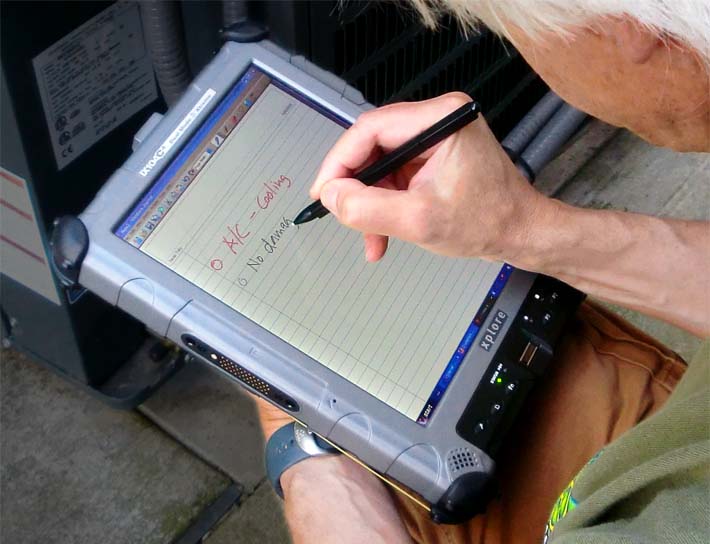
What has changed?
There was no need to change one of the best rugged tablet computer designs on the market, and so the new top-of-the-line Xplore retains the exterior looks and concept of Xplore Technologies' existing iX104C3 and iX104C2 lines. The bezel of the super-tough triple-layer magnesium housing is now gray instead of blue, but the primary improvements are inside the machine.
On the technology side, Xplore switched from a low-voltage Intel 738 M processor setup to a more efficient ultra-low-voltage Core Duo U2500 processor with the accompanying 945GME chipset. In addition to offering a slightly lower thermal design power (TDP) of 9 versus 10 watts, the U2500 is, of course, an entirely more modern design that employs two processing cores as well as additional Intel improvements. The U2500 has become the chip of choice in the high performance rugged tablet market, and Xplore made a good decision selecting it for its new flagship product.
There are other technology improvements. The machine now offers up to twice the amount of video memory (128MB max) as well as twice the amount of RAM (up to 2GB of DDR2 SDRAM). Disk technology switched from the older PATA interface to the faster SATA, and standard disk capacity grew to 120GB. Also new is the availability of an optional 32GB Solid State Disk (SSD). SSDs are still more expensive than rotating media hard disks but offer speed and ruggedness advantages. Making this option available is a good move, and larger SSDs will soon be readily available.
Wireless communications is also faster thanks to the inclusion of an 802.11AGN module that can take advantage of the much quicker "N" protocol while remaining compatible with legacy 802.11b/g networks. Xplore also supports EV-DO Rev. A and HSPA as well as a unique external 12-Channel GPS module with WAAS/EGNOS correction capabilities (EGNOS stands for European Geostationary Navigation Overlay Service and is a satellite-based augmentation system; it is similar to the Wide Area Augmentation System used in the US). Up to four radio systems can be operated at the same time.
On the security side, Xplore had already equipped the iX104C4 with a conveniently located fingerprint scanner and accompanying security software suite. The new machine now also includes a TPM 1.2 module. The Trusted Platform Module technology employs hardware that stores cryptographic keys for a variety of encryption levels. The iX104C4 also has user-accessible internal slots, thus making it possible to remove critical data storage components -- an important security consideration.
Benchmark performance
Unlike manufacturers of desktop computers and notebooks that will mostly be used in an office, designers of mobile hardware must carefully balance size, weight, performance and battery life. Ideally, a mobile computer has a large display, long battery life, great performance, all at low weight and acceptable cost. In real life, those desirable qualities are more or less mutually exclusive, which makes designing a mobile computer an exercise in optimization. The machine must be powerful and tough enough and have a large enough display while also being light and handy enough, and having good enough battery life. This requires good engineering and knowing the priorities of your customers -- two qualities the folks at Xplore Technologies have always been good a.
Performance is always important, and especially so in a new product. To see where the new Xplore fits in we ran Passmark Software's PerformanceTest 6.1, a suite of about 30 tests covering CPU, 2D graphics, 3D graphics, memory, and disk and then computes scores for each category and an overall PassMark score. For comparison, we're listing two machines that use the same Core Duo U2500 processor and are direct competitors to the Xplore machine. The DRS ARMOR X10 also shares the Xplore's 10.4-inch screen size whereas the General Dynamics machine has an 8.4-inch display. All machines ran Windows XP SP2.
|
PERFORMANCE COMPARISON
|
Xplore iX104C4
|
DRS Armor X10
|
GD-Itronix DT-II
|
|
Processor
|
1.2GHz Intel Core Duo U2500
|
1.2GHz Intel Core Duo U2500
|
1.2GHz Intel Core Duo U2500
|
|
Thermal Design Power (TDP)
|
10.0 watts
|
10.0 watts
|
10.0 watts
|
|
CPU Mark
|
612.1
|
604.4
|
631.1
|
|
2D Graphics Mark
|
152.6
|
161.1
|
164.4
|
|
Memory Mark
|
245.7
|
243.4
|
240.6
|
|
Disk Mark
|
326.5
|
232.7
|
318.8
|
|
3D Graphics Mark
|
98.1
|
99.4
|
101.4
|
|
Overall PassMark
|
307.9
|
288.0
|
312.6
|
The results show that the iX104C4 can holds its own against the high performance competition in the rugged slate field. As far as the choice of the Core Duo U2500 goes, few except the Dells and HPs of this world can keep up with Intel's ever-changing processor line-up, and the power efficient U2500 will remain a good compromise between efficiency and performance for some time to come.
Exemplary design
The iX104C4 is a rugged Tablet PC slate computer. It has a footprint of almost exactly an American-standard 8.5 x 11 sheet of paper and is just over an inch and a half thick. Our test machine weighed exactly 5.25 pounds including battery. The machine's housing is made of magnesium and feels solid as a rock, without any twisting or creaks. The top part of the clamshell housing takes up about two thirds of its overall thickness and has a very fine steel-gray powdercoat finish. The bottom part has the same fine powdercoat finish but is very dark gray.
For protection against scratches and other harm there are thick rubber bumpers on all eight corners. Rugged computers must also be sealed against dust and liquids, something that's most easily accomplished with as few external ports and openings as possible. However, some onboard connectivity is needed so as not to impede functionality in the field, and Xplore has always offered a rational balance of onboard and docking connectivity. The iX104C4 is no exception and there are two USB 2.0 ports and gigabit LAN onboard. Since there are still a lot of field peripherals using a serial interface, the iX104C3 has a RS232/422/485 port as compared to the video port on the iX104C3.
Below you can see the Xplore iX104C4 from the front and all four sides:
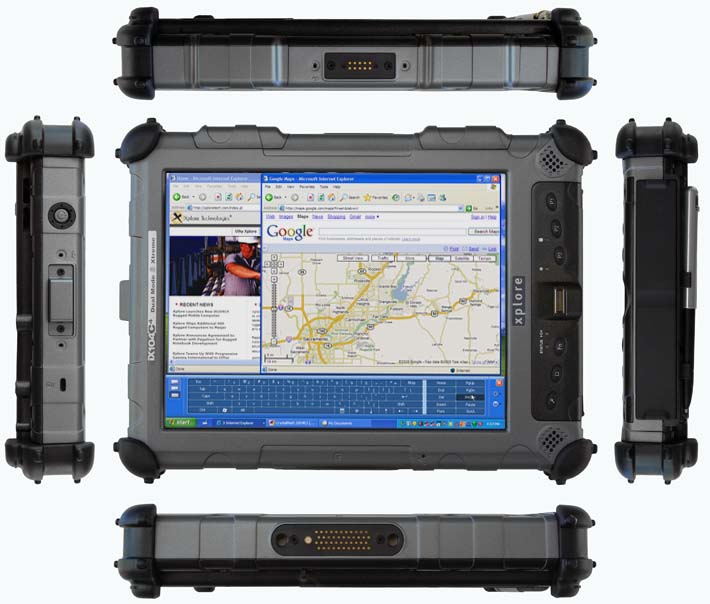
The front view shows that while many customers will use the machine in landscape mode, it was actually designed with a primary portrait orientation (see the labels). Used in portrait mode, the stereo speakers are properly located to the left and right, and the central fingerprint scanner is flanked by three illuminated hardware buttons on each side. To the right are three programmable buttons that launch applications. To the left are the "security" key, a screen rotation button (toggles 90 degrees back and forth), and a function button that essentially doubles the number of programmable keys from three to six.
On the left side is the on/off switch and, beneath a screw-on cover, a SIM card slot. The right side houses the computer's ports, covered and protected by flip-open rubberized plastic doors. The picture above shows the doors closed. On top you get a RJ45 LAN port and a DB-9 serial port, on the bottom power, audio in and out, and two USB connectors. The top shows a surface-mount set of contacts, as does the bottom which additionally also has an antenna pass-through. Along the top of the unit are also two antennas under plastic covers that match the design and finish of the magnesium housing so closely that you think they're part of it.
If you turn the unit on its back (see right) you can see the garage for the active Wacom pen. The pen, which snaps into place in two rubber clips, is a slightly customized version with an aluminum back that has a hole in it so it can be tethered to the computer.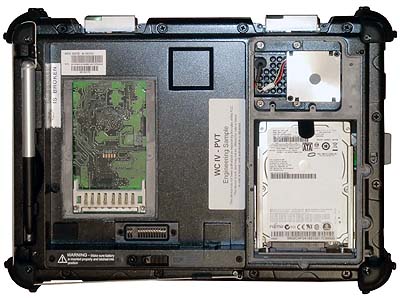
A large magnesium plate covers both the unit's fan and its hard disk compartment. The fan side of it has ventilation holes, but the design is such that the hard disk compartment is sealed separately. The very quiet fan of the heat exchange module can handle water and even runs underwater.
The iX104C4's hard disk is a 120GB Fujitsu model MHY2120BH with a Serial ATA interface and spinning at 5400 rpm. The disk sits shock-mounted in a caddy with dense neoprene padding.
The battery (removed in the picture) is a large 6.3 x 5.9 x 0.6 inch affair that recesses into the bottom of the computer. It is powerful, too, packing 56 watt-hours (7.4V/7,600mAH). Below the battery is another screw-down magnesium cover with a rubber seal that seals away a PC Card Type II connector. The battery very securely snaps into place via a locking mechanism where you first have to depress a button, then move a lever sideways. There is no way that the battery will ever be released accidentally.
The picture below shows the right side of the machine in more detail. Note that the protective covers have been Photoshopped away to get a better look at the interface blocks.

Sunlight-viewable display
Computers used in the field need displays that can be viewed outdoors and even in direct sunlight. That can be a daunting challenge, one that in the past has proved to be almost insurmountable.
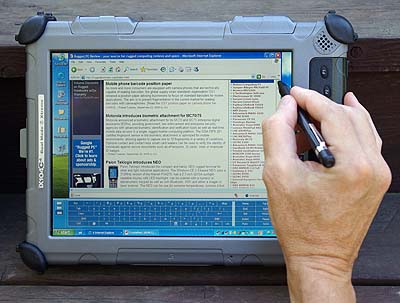 RuggedPCReview.com's technology editor, Geoff Walker, notes that "there are really only two practical methods of making a notebook screen readable outdoors: (a) crank up the brightness (measured in nits, which is display-industry slang for "candela per meter squared", or cd/m2) to the point where the light emitted by the screen is sufficiently greater than the ambient light reflected by the screen, or (b) treat the surface of the screen so it reflects much less light, which again allows the emitted light to exceed the reflected light.
RuggedPCReview.com's technology editor, Geoff Walker, notes that "there are really only two practical methods of making a notebook screen readable outdoors: (a) crank up the brightness (measured in nits, which is display-industry slang for "candela per meter squared", or cd/m2) to the point where the light emitted by the screen is sufficiently greater than the ambient light reflected by the screen, or (b) treat the surface of the screen so it reflects much less light, which again allows the emitted light to exceed the reflected light.
Xplore had a good sunlight-viewable display when no one else did. The latest version, called AllVue Xtreme, is 50% brighter. This is big news. When it comes to sunlight viewability, it's the effective contrast ratio of the display that matters. This ratio is computed as 1 + (emitted light / reflected light). By boosting screen brightness, the effective contrast ratio is now higher, thus further improving the display. Xplore says the effective contrast ratio is around 8, an excellent figure for a touchscreen-equipped display.
To see how far display technology has come we compared an old Toshiba Portege 3500 Tablet PC convertible that we're still using around the RuggedPCReview office and on trips with the Xplore iX104C4. The 2002 Toshiba did not specifically claim sunlight viewability, but the pictures show dramatically what the combination of a strong backlight and anti-reflective optical coatings can do. We also compared the Xplore machine to direct competitors and it can more than hold its own.
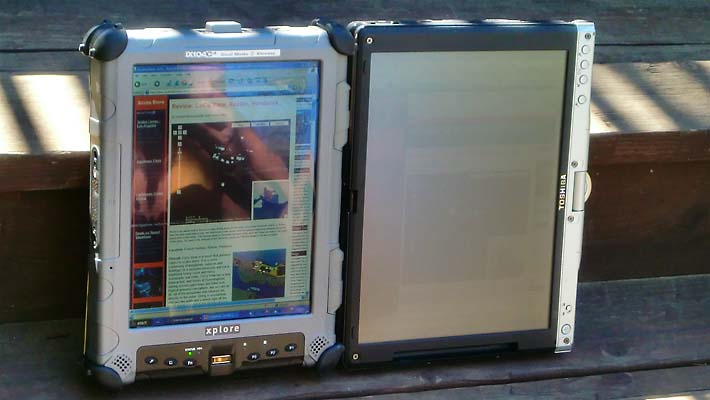
The comparison above shows how bright and crisp the Xplore's AllVue Xtreme display remains in bright daylight, with the screens facing away from the sun. One small price to pay is that there are some reflections in the Xplore's glossy display surface. The Toshiba display's anti-glare properties eliminate reflection, but the display still becomes unreadable.
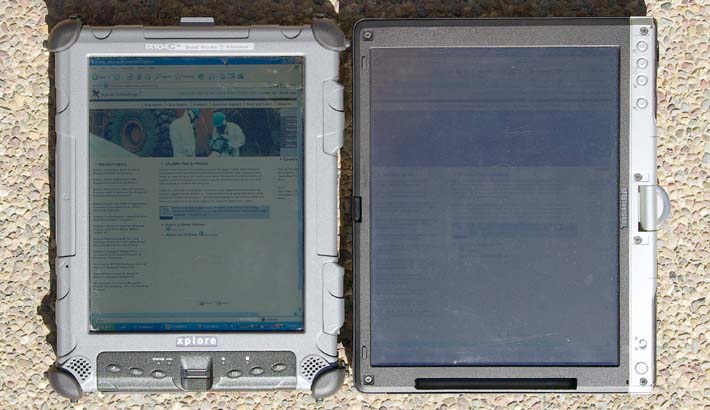
Above you can see a worst-case scenario, with both displays facing directly into the mid-day sun where even a strong backlight is no match for the sun. The Portege's display becomes very difficult to read whereas the Xplore's remains perfectly readable. In real life it actually looks better than in the picture.
In everyday use outdoors, the Xplore display was a pleasure to use. It is bright and clear and offers very good contrast.
The iX104C4's display surface is not totally flat like a plate of glass. There are some optical distortions, especially along the perimeter, and those can cause distracting reflections. We've become spoiled by the Hydis LCDs that have near-perfect 180 degree viewing angles from all directions. The Xplore display has an almost 180 degree viewing angle horizontally, but a rather narrow one with significant color shifts vertically.
Dual Mode touch screen and active digitizer
Ever since the dawn of pen computing back in the early 1990s, there have been touch screens and active digitizers. Touch screens respond to the touch of a finger or stylus and the cursor will jump to whatever point is touched on the display, but there is no "cursor tracking" where the cursor follows the finger or stylus without the screen being touched. This can make it difficult to work with applications where precise cursor placement is needed. Active digitizers, on the other hand, can sense the tip of a special pen and the cursor will follow it as it hovers in close proximity (usually about half an inch) of the display surface. This makes very precise cursor placement possible, but if you lose the pen you're out of luck as the display does not respond to touch of any kind.
This is why Tablet PC manufacturers are now moving to displays that combine touch and a digitizer. Xplore has had such a Dual Mode touch/digitizer for years and their system is auto-sensing. It works as a touch screen until it senses the proximity of an active pen. Then it stops responding to touch input and the cursor follows the pen. If it can no longer sense the pen, it once again responds to touch. This system is a lot simpler than having to manually switch between two modes.
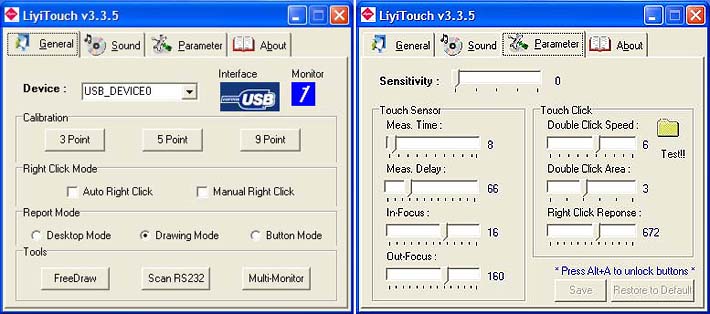
The touch screen comes with a LiyiTouch utility panel that lets you configure the various touch functions and parameters.
- General defines touch actions (right mouse clicks, calibration type, a number of tools)
- Sound lets you set and define a sound or buzzer mode
- Parameter sets sensitivity, click area, click speed, delays and so on
- About provides links, help and info.
The "reporting modes" of the touch screen can be set to "desktop" where touch works like a mouse. In "drawing" mode, holding the touch is like pressing and holding the left mouse button. In "button" mode, the cursor will go to where you touch the screen, but will not follow your finger when you drag. This is perfect for pure touch applications.
Being able to set a sound or buzzer for when you touch or release the screen can come in handy in certain vertical market applications where an audible notification confirms touch and release.
The touch screen is very responsive and a pleasure to use.
The Wacom digitizer, on the other hand, has its pros and cons. Everyone likes the slender pens that do not need a battery, and the technology is mature. On the other hand, it is difficult to calibrate precisely as all you get is four calibration points. That is not enough for a digitizer that tends to become imprecise along the display perimeter. This is a Wacom issue and not a Xplore issue. Having a margin between the perimeter of the LCD and the magnesium bezel or a flush-mount display would help.
Power
When it comes to battery size, makers of mobile computers must make a compromise. A big battery provides longer battery life, but it is larger and weighs more. Xplore is giving iX104C4 customers two choices. The standard 6-cell battery is rated at 41 watt-hours and, according to Xplore, lasts up to 3.5 hours. An optional 8-cell battery provides 56 watt-hours, good for an additional hour. Normally, extended batteries either mean a bulge or they snap onto the back of the device, adding to its size. This battery, however, fits flush into the same compartment as the standard battery. To us that makes it the preferable choice.
Wireless and expansion
Onboard wireless communication is mandatory today and almost all mobile computers have at least basic wireless capabilities. Basic, however, doesn't cut it in the rugged/vertical markets that require performance and reliability even under difficult environmental conditions. As a result, Xplore offers all the usual wireless systems, including WiFi, WWAN, Bluetooth and GPS, but you also find a sealed mini-PCI Express based OEM radio bay and an externally accessible SIM card compartment. Antennas are specially designed and integrated into the unit, which means no protrusions that can get caught and break off. And you can operate all wireless systems simultaneously.
Snap-on modules
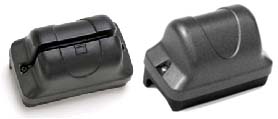 Another unique solution available for the iX104C4 are "snap-on modules." They snap and screw onto the top and left side of the computer, providing additional functionality. The snap-on 16 parallel channel xGPS module supports DGPS and multiple satellite based augmentation systems (SBAS) such as WAAS or the European Geostationary Navigation Overlay Service (EGNOS). The module provides fast start-up and excellent navigation performance under rugged conditions. Another unique solution available for the iX104C4 are "snap-on modules." They snap and screw onto the top and left side of the computer, providing additional functionality. The snap-on 16 parallel channel xGPS module supports DGPS and multiple satellite based augmentation systems (SBAS) such as WAAS or the European Geostationary Navigation Overlay Service (EGNOS). The module provides fast start-up and excellent navigation performance under rugged conditions.
The xSwipe module is a magnetic stripe reader that lets the iX104C4 capture information from medical cards, drivers' licenses, identification cards and credit/debit cards. Having that capability available makes the iX104C4 suitable for a variety of extra applications.
Launch buttons and the Panel Control Center
Since pen computers do not have a physical keyboard, they rely on buttons, utilities and screen shortcuts to get things done. Xplore gave the iX104C4 six programmable launch buttons for one-touch access to often used functions.
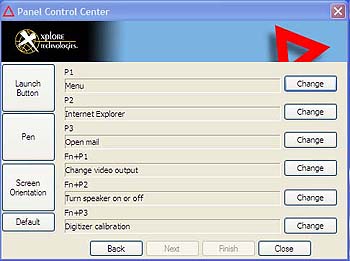
The launch buttons can be programmed in the Panel Control Center in three different ways. You can have a button (or Function-button) to:
- launch an application, document, web page or multimedia file,
- start a pre-defined function such as "change video output," or "radio toggle",
- issue a key or key combination (using Ctrl, Alt, Shift, etc.). This brings up an onscreen keyboard to select the keystroke combination.
What this means is that certain vertical market or industrial applications can be controlled entirely through the six programmable function keys.
The Panel Control Center also provides direct access to touch panel or digitizer calibration, and you can enable or disable screen rotation and also set screen orientation.
xDock mounting solutions
While the Xplore iX104c4 is a mobile system, it will also be used in vehicles, on loading docks, on shopfloors, in offices, and in many other locations and settings. Which means it needs a variety of mounting solutions.

This is where Xplore's xDock comes in. It is a versatile multi-purpose docking system that is compatible with all of Xplore's iX104 computers. It can be configured with a variety of I/O connection options via a port replicator module or a dock interface module. Computers mounted in an xDock tilt and swivel any which way and can be installed either in portrait or landscape mode.
The port replicator offers two USB 2.0 ports, FireWire, audio in and out, video, two RS232 virtual serial ports, a virtual printer port, and a coaxial antenna pass-through. Also available is the xDim module for in-vehicle use. It adds vehicle antenna control, a vehicle power connector, and AC/DC adapter plugs.
Security
Like most mobile hardware these days, the iX104C4 offers various levels of hardware and software security to prevent unauthorized access as well as theft.
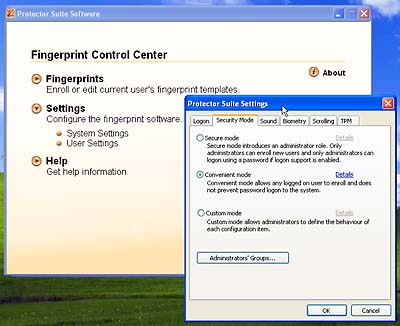 The Protector Suite QL from UPEK Software Products handles Fingerprint scanning. Initial setup enrolls any number of fingerprints to the hard disk. The system then sets up an enrollment record that combines the Windows user name, password, fingerprint and an automatically generated security key that cannot be reconstructed. To enroll, you enter your user name and password, then select which finger(s) you want to use, then have the fingerprint scanner scan your finger(s) three times. The fingerprint is now registered and locked to your user name and password. You can do a swipe to bring up the security control center from where you can fine-tune security. The Protector Suite QL from UPEK Software Products handles Fingerprint scanning. Initial setup enrolls any number of fingerprints to the hard disk. The system then sets up an enrollment record that combines the Windows user name, password, fingerprint and an automatically generated security key that cannot be reconstructed. To enroll, you enter your user name and password, then select which finger(s) you want to use, then have the fingerprint scanner scan your finger(s) three times. The fingerprint is now registered and locked to your user name and password. You can do a swipe to bring up the security control center from where you can fine-tune security.
As part of its security, the Xplore iX104C4 uses Trusted Platform Module (TPM) 1.2 hardware to create and manage computer-generated digital certificates. Combined with software, these certificates can be used to:
- Send and received secure email,
- Set up the browser for client identification,
- Sign Word macros,
- Encrypt individual files or entire folders, and
- Create secure network connections.
To use TPM, you have to enable TPM support in the BIOS and then configure the system with the Infineon Security Platform Settings Tool and the UPEK Protector Suite.
All of this can get pretty involved. Some users may never implement TPM or even passwords, whereas others may be set up in accordance with their company's IT security procedures, or they may configure an individual system for maximum security.
Over all this, don't forget physical security and get a Kensington locking cable to use with the Kensington slot on the backside of the unit. It is inexpensive insurance against theft.
Ruggedness
The Xplore iX104C4 is a rugged machine able to handle just about any environmental condition, and it has the specs to prove it.
The machine has a very wide operating temperature range of -4 to 140 degrees Fahrenheit. I am not sure if that pertains only to models equipped with solid state disks or hard disk models as well. Since the standard disk comes with a hard drive heater, it can likely start and operate in lower temperatures than consumer class computers. The iX104C4 is also tested for thermal shock.
Vibration and transit shock are tested according to the procedures described in MIL-STD-810F, methods 514.5 and 516.5. Since mobile computers are always in danger of being dropped, the "drop spec" is of special importance. Thanks to its rugged construction and protective rubber bumpers, the iX104C4 can handle 4-foot drops to concrete on all surfaces, edges and corners.
Sealing is important as well, and here the Xplore machine can ward off the elements with an IP65 equivalent rating. "6" means it is completely dustproof, and "5" means it can handle water jets from all directions without leaking.
As always, your particular application will make the ability to pass some of those tests either vital or meaningless.
Bottom line
Overall, what we have here is a very smart technology update to what already was one of the best rugged Tablet PCs on the market. Xplore improved several key areas, now providing even better performance and real-world usability. 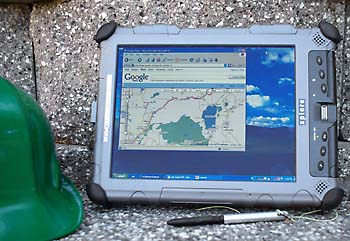 With the Xplore iX104C4 customers get a compact Tablet PC slate almost exactly the size of a sheet of paper and weighing just over five pounds. Thanks to its heavy-duty magnesium housing, thick protective rubber bumpers, and sealing against dust and liquids, the iX104C4 can operate under just about any conditions and take a lot of abuse. With the Xplore iX104C4 customers get a compact Tablet PC slate almost exactly the size of a sheet of paper and weighing just over five pounds. Thanks to its heavy-duty magnesium housing, thick protective rubber bumpers, and sealing against dust and liquids, the iX104C4 can operate under just about any conditions and take a lot of abuse.
Among the areas where the iX104C4 excels are the very bright 10.4-inch XGA (1024 x 768 pixels) sunlight-viewable AllVue Xtreme display and the Dual Mode interface that intelligently combines both an active digitizer and a touch screen. The computer can be used in touch screen mode but will instantly switch to digitizer mode when it senses the proximity of a pen. No need for manually switching back and forth.
The machine now uses a powerful, yet economical Intel dual core processor, can be equipped with up to 2GB of memory, a fast 120GB serial ATA disk, or an optional 32GB (and probably soon even larger) Solid State Disk for extra performance, ruggedness and reliability.
Wireless communications is also faster thanks to the inclusion of an 802.11AGN module that can take advantage of the much quicker WiFi "N" protocol while remaining compatible with legacy 802.11b/g networks. Xplore also supports EV-DO Rev. A and HSPA as well as a unique external 12-Channel GPS module.
For security there is a conveniently located fingerprint scanner and accompanying security software suite. The new machine now also includes a TPM 1.2 module. The Trusted Platform Module technology uses hardware that stores cryptographic keys for a variety of encryption levels, thus making data safer.
With this latest update to its iX104 line, Xplore Technologies stays at the very front of rugged computing hardware.
-- Conrad H. Blickenstorfer
Xplore iX104C4 Specs:
| Type |
Rugged Tablet PC slate
|
| OS |
Windows XP Tablet PC
|
| Processor |
1.2GHz Intel Core Duo U2500
|
| Display Chipset |
Intel 945GME - 533MHz with up to 128MB video memory
|
| Memory |
1024MB/2048MB DDR2 |
| Display |
10.4" XGA (1024 x 768) transmissive TFT or optional AllVue Xtreme for enhanced outdoor viewing
|
| Digitizer |
Dual Mode: Active electromagnetic (Wacom), strengthened and coated glass and resistive touch digitizer |
| Keyboard |
Optional external USB |
| Storage |
Fujitsu 5400rpm 120GB SATA or 32GB Solid State Drive
|
| Expansion slots |
SIM Card, User-accessible PC Card Type II/III and OEM radio bay
|
| Housing |
Triple layer Magnesium housing with bumpers |
| Size (inches) |
11.2 x 8.25 x 1.60 |
| Weight |
5.25 lbs.
|
| Operating temperature |
-4 to 140 degree Fahrenheit |
| Ingress protection |
IP65 |
| Shock |
4-foot drop to concrete, all surfaces, edges and corners |
| Vibration |
MIL-STD 810F method 514.5C-17 |
| EMC |
inquire |
| Safety |
inquire |
| Humidity |
MIL-STD 810F method 507.4 (0 to 95% non-condensing) |
| Power |
Li-Ion (7.4 V/5,700mAH, 41 watt-hours) "up to 3.5 hours"; optional 7.4 V/7,600mAH 56 watt-hour extended life battery for up to 5 hours |
| Interface |
2 USB 2.0, gigabit LAN, RS232/422/485, fingerprint scanner; via xDock: 2 USB, FireWire, CRT, 2 RS232/422/485, 1 coax, audio in/out, virtual printer |
| Wireless options |
802.11AGN, Bluetooth; optional: HSPA, EV-DO Rev. A, 12-channel GPS (external module); all can be used simultaneously
|
| Price |
Starting mid-$3,000 range |
| Contact |
Xplore www.xploretech.com |
(copyright 2008 RuggedPCReview.com)
Xplore Technologies
14000 Summit Drive, Suite 900
Austin, TX 78728, USA
Toll Free: 1-888-449-7567
Phone: 1-512-336-7797
Fax: 1-512-336-7791
info@xploretech.com
www.xploretech.com
Xplore Technologies
Sinimaentie 8b
02630 Espoo, Finland
Tel: +358 9 4730 2671
Fax: +358 9 4730 2679
international@xploretech.com
|



